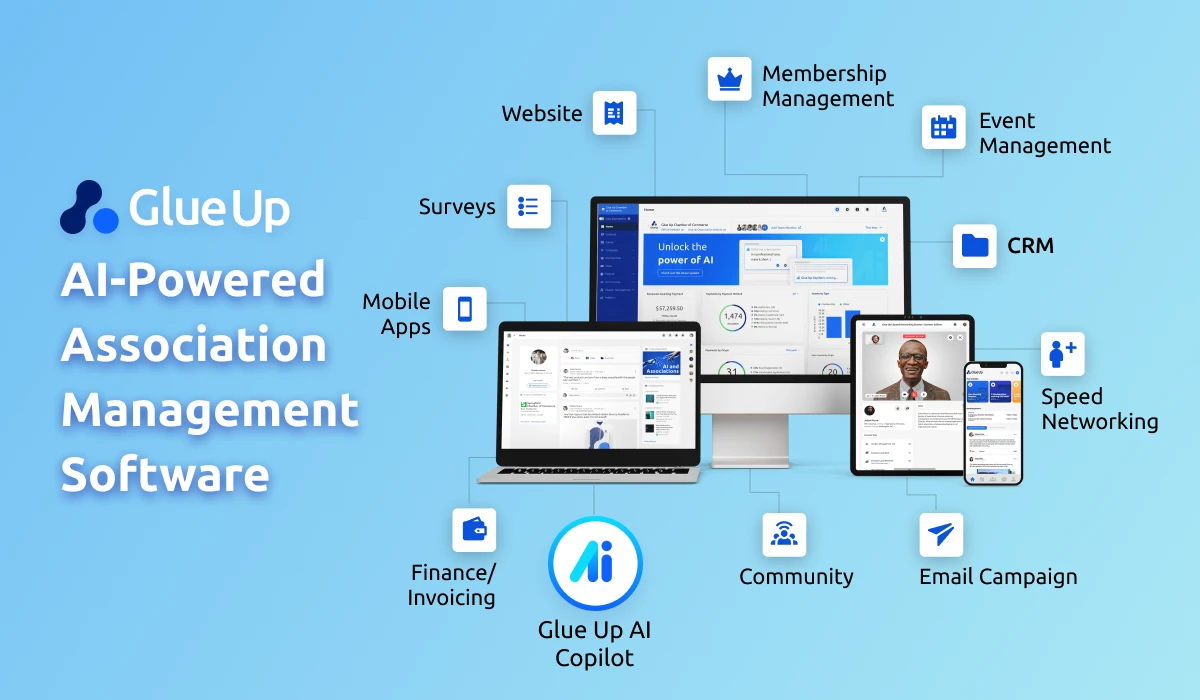
For associations, staying competitive involves tackling challenges like member engagement and adapting to changing needs. Marketing strategies are always changing, with some trends having a bigger impact than others.
As Jay Baer puts it, “Marketing is not a task, it is an ongoing process that requires constant attention and adaptation.” This highlights the need to remain informed and flexible.
However, this blog focuses on the latest marketing trends. We’ve identified the top 9 trends that can help address these challenges and improve your approach. Read on to learn how you can improve your strategy and stay ahead.
Key Takeaways
- Staying competitive in marketing requires organizations to adapt to new trends and data-driven strategies.
- Video is powerful for engagement, and short-form content is dominating platforms like TikTok and Instagram.
- Embracing sustainable and ethical practices strengthens an organization's reputation and member loyalty.
- Optimizing content for conversational language is crucial as voice search continues to rise.
- Glue Up centralizes data, simplifies event management, and enhances communication, supporting productive marketing strategies.
1. Budgets & Hiring Trends Favor Data Roles
Marketing trends have shifted from creative roles to more data-oriented roles.
As cost-effectiveness becomes a key strategy, companies are increasingly relying on data to guide their decisions. About 58% of companies use A/B testing for conversion rate optimization, reflecting its widespread use in refining marketing strategies. Businesses test variations to identify the most effective approach, enhancing efficiency.
It's important to note that only one out of eight A/B tests drives significant change, emphasizing the need for careful analysis to achieve meaningful results.
Data alone is not enough; skilled marketers are essential for interpreting successes, problems, and trends. The large amount of data available can sometimes confuse marketers and lead them to focus on less relevant metrics, potentially missing fundamental marketing principles.
2. Influencers with Fewer Followers Have Higher Engagement
Influencers originally needed to have hundreds of thousands to millions of followers to land marketing gigs, but this trend is changing.
Today, it’s more important to focus on influencers who are closely aligned with your audience. This often means they may have fewer followers, and that’s actually a positive aspect.
Choosing the right influencer for your target audience, even with a smaller following, tends to result in higher engagement. Refer to the above image to see a sample data set on this relationship.
3. Social Media as a Customer Support Platform
While email and phone remain strong channels for customer support, social media is quickly becoming a useful option for direct engagement. Social media's ease of use and constant notifications keep your members engaged and help show that your company is open and transparent.
In fact, 67% of customers find contacting customer support on social media convenient, highlighting the need for a strong social media presence to meet the preferences of those who choose these platforms for communication. Social media is cost-effective, and moving member interactions to these platforms can enhance your brand’s reputation as approachable and responsive.
Additionally, the distinction between social media and messaging apps like WhatsApp, Facebook Messenger, and WeChat is becoming less clear. Many businesses now add links to these messaging apps on their websites for easier customer contact.
Social media platforms are also adding features to support this trend. For instance, Facebook now allows businesses to add chat options directly to their websites, making it easier for customers to reach out. This method helps create a sense of community, allowing members to help each other and answer questions before your team has a chance to respond.
4. Video is a Growing Engagement Area
Video remains one of the most effective tools for engaging users and encouraging purchases. When done well, it can attract, convince, and persuade viewers to view your product or service positively.
The length of the video affects viewer engagement. Longer videos often help build a deeper connection with your brand, while shorter videos are more likely to be shared if they are interesting, entertaining, or informative. However, it's important to maintain content quality and keep viewers interested throughout the video.
Video performance depends on the platform and medium used. Here are some updated tips:
- YouTube: Post longer videos on YouTube, as the platform often promotes longer content. However, maintaining viewer interest is key to effectiveness.
- Subtitles: Always include subtitles for social media videos, as they are often played on mute by default.
- Initial Seconds: The first few seconds of a video are crucial for grabbing attention as people scroll through their feeds.
- Short-Form Videos: Short videos work well on platforms like TikTok and Instagram Reels. They are less effective on YouTube but can still perform on Facebook.
- LinkedIn: LinkedIn allows videos that last up to 10 minutes. For better engagement, make sure the content is relevant to professional interests.
Interactive videos with features like polls and clickable links are becoming more popular, and live streaming offers real-time interaction, which can also enhance viewer engagement.
5. AI-Powered Personalization is Transforming Marketing

Personalization is changing marketing by creating customized member experiences. Here’s how:
- Enhanced Insights: Analyzing large datasets helps understand member preferences and behaviors, leading to more relevant marketing strategies. Fast-growing companies earn 40% more of their revenue from personalization than slower-growing ones, showing the financial benefits of tailored marketing.
- Personalized Content: Recommendations based on individual interests boost engagement and satisfaction. About 76% of consumers get frustrated when personalization doesn’t happen, highlighting the need for customized content.
- Optimized Email Campaigns: Tailoring email content in real-time improves open and conversion rates.
- Chatbots and Assistants: Automated chat systems offer instant, personalized support and product suggestions.
- Predictive Analytics: Forecasting customer behavior helps businesses predict needs and stay ahead.
- Automated Segmentation: Grouping customers based on shared traits enables more targeted marketing.
- Real-Time Personalization: Adjusting content and offers based on live user interactions ensures relevance.
Personalization improves marketing effectiveness by delivering customized experiences and enhancing customer engagement.
6. Sustainable and Ethical Marketing is Gaining Momentum
Sustainable and ethical marketing is becoming more important for organizations and associations as they focus on environmental and social responsibility. Members increasingly prefer organizations that demonstrate commitment to these values, which can lead to greater loyalty and a stronger reputation.
Organizations are being more transparent about their practices, including how they source materials and their environmental impact. To help reduce their environmental footprint, they are also offering eco-friendly options, such as those made from recycled materials or with minimal waste.
Supporting fair trade ensures responsible sourcing and fair wages while participating in social responsibility initiatives, which shows a commitment to positive social impact.
Moreover, adopting sustainable marketing practices, like reducing paper use and digital waste, highlights an organization’s dedication to environmental care. Educating members about the benefits of choosing sustainable and ethical options encourages more responsible decisions.
Embracing these practices can improve an organization’s position, build trust with members, and contribute positively to society and the environment.
7. Short-Form Content is Dominating Social Media

Short-form content is taking over social media, driven by its ability to quickly capture attention and deliver messages effectively.
Here’s why it’s so popular:
- Instant Engagement: Short-form content, such as brief videos, memes, and quick posts, grabs attention quickly and is easy to consume, leading to higher engagement rates. In fact, 68% of viewers thoroughly watch business videos that are shorter than one minute.
- Mobile-Friendly: With more users accessing social media through mobile devices, short-form content fits perfectly on small screens and is ideal for quick browsing.
- High Shareability: Concise and catchy content is more likely to be shared, expanding reach and increasing visibility.
- Effective Messaging: Brief content can deliver a clear message or call-to-action without overwhelming the audience, making it more effective in driving user action. Over 85% of marketers believe short-form videos are the most effective in marketing.
- Frequency of Posting: Short-form content allows for frequent posting, keeping your brand top-of-mind and maintaining consistent interaction with your audience.
Organizations and associations can leverage short-form content to engage with their members and followers more effectively, driving higher interaction and visibility on social media.
8. Voice Search Optimization is Becoming Crucial

Voice search is growing rapidly as more people use smart speakers and voice assistants to find information online.
Optimizing for voice search is essential because it changes how users phrase their queries, often using natural, conversational language. This shift means organizations must adjust their SEO strategies to include long-tail keywords and question-based phrases that align with how people speak.
Additionally, ensuring that content is easily accessible and quickly answerable can enhance visibility and improve member experience. As voice search continues to rise, staying ahead with proper optimization will be key to maintaining a strong online presence.
Maximize Your Marketing Potential with Glue Up

To succeed in marketing for your organization, adopting trends is essential, but having an effective association management solution is equally crucial. Glue Up provides a range of features that can significantly enhance your marketing efforts:
Membership CRM: Centralize all your data in one place and gain clear insights into your community. This organization of data makes understanding engagement levels and improving your campaigns much easier.
Event Management: Plan, promote, and execute online or offline events of any size efficiently with Glue Up’s top-rated solution. Features like an event website builder, branding options, and branded invitations streamline the event management process, making it easier to attract and engage your audience.
AI Copilot: Boost your marketing with AI-driven content creation. Glue Up's AI Copilot assists in writing email campaigns, surveys, and event descriptions, ensuring your communications are effective and tailored to your audience.
Community Engagement Analysis: Analyze community engagement with detailed insights into contact information and membership status. With this information, tailoring your marketing strategies to better meet the needs of your members and potential clients becomes more straightforward.
Finance Automation: Automate all your finance processes and easily track payments. Centralized payments, financial reports, and real-time analytics provide a clear view of financial performance, allowing you to focus on growing your organization.
Integrating Glue Up’s features into your marketing strategy enhances efficiency, improves engagement, and drives success for your organization. Book a demo to see how Glue Up can transform your marketing efforts.

![Advantages Of Paperless Board Meetings [+ Tips] Advantages Of Paperless Board Meetings [+ Tips]](/sites/default/files/styles/all_blogs_block_img_384x192/public/image_1578.png?itok=Ah-vnnvq)

![PayPal for Nonprofits: A Guide to Accepting Donations and Managing Your Money [with alternatives] PayPal for Nonprofits: A Guide to Accepting Donations and Managing Your Money [with alternatives]](/sites/default/files/styles/all_blogs_block_img_384x192/public/image_1807.png?itok=ujDAsFNj)